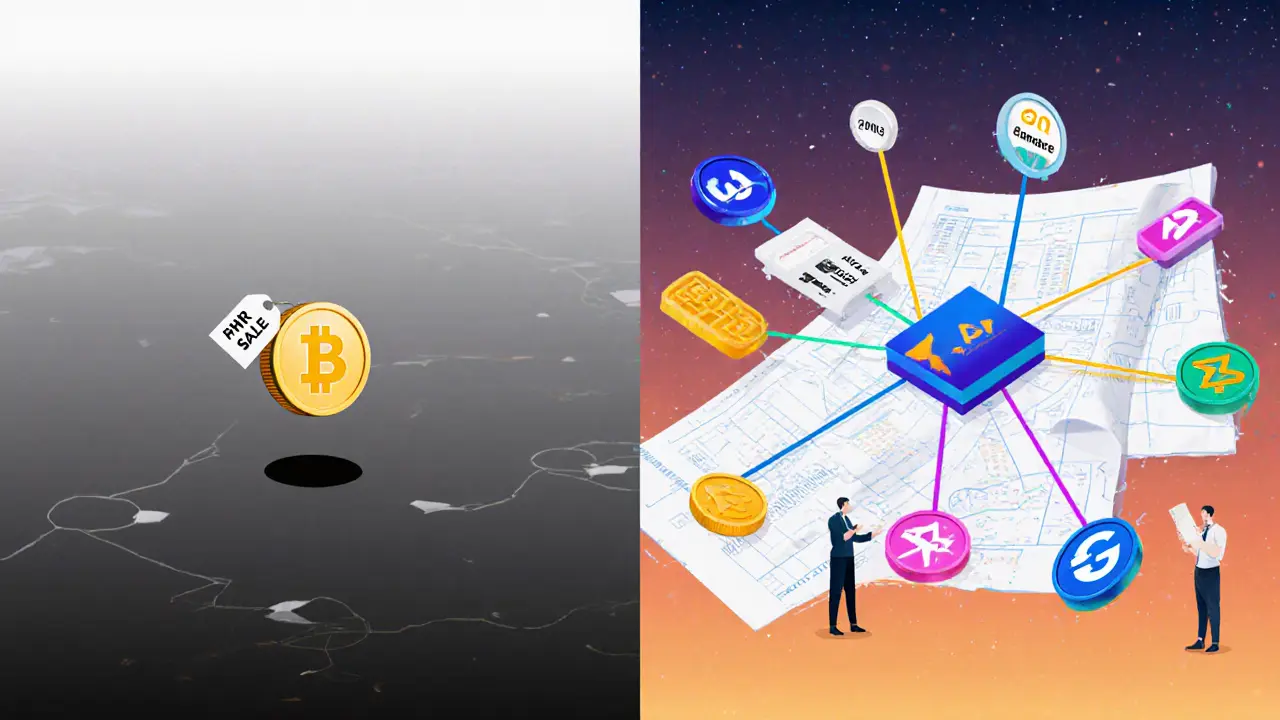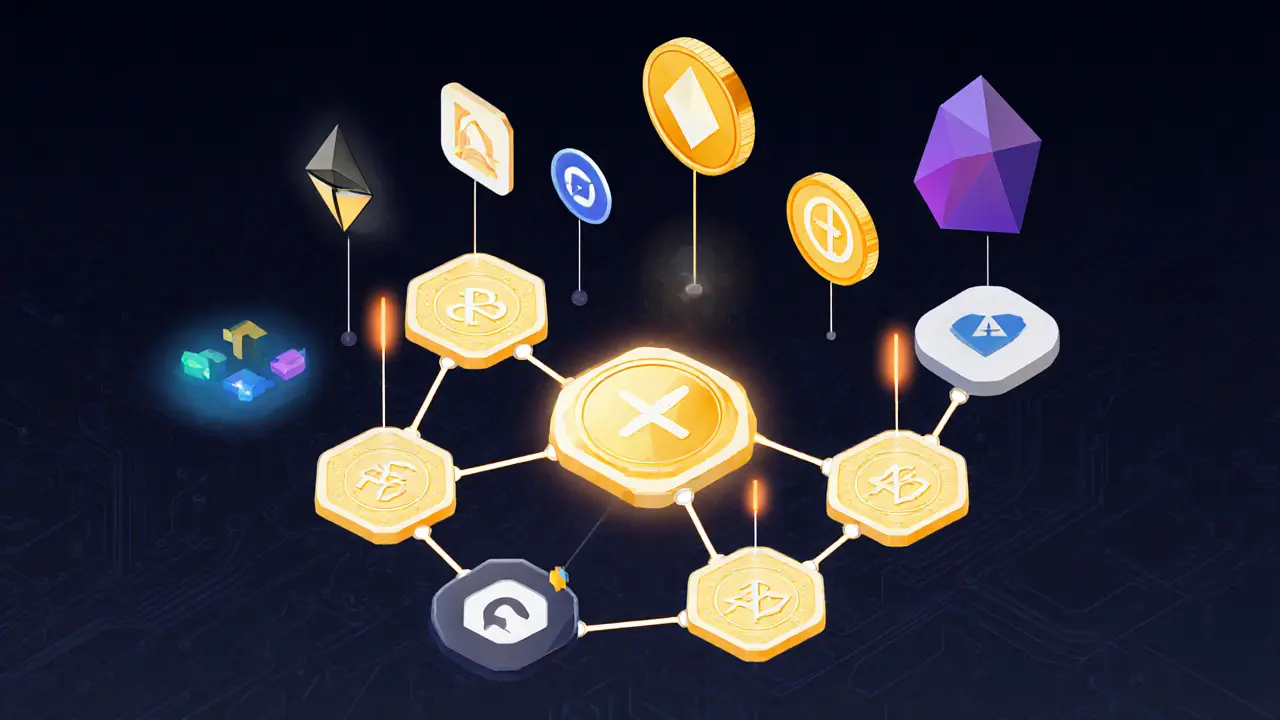PHTR Slippage Calculator
PHTR Slippage Calculator
Estimate how much price impact you'll experience when buying or selling PHTR based on current liquidity levels.
Estimated Slippage
Market cap: Under $250,000
Understanding Slippage
Slippage occurs when the price you see when placing a trade is different from the actual price when the trade executes. With PHTR's low liquidity, even small trades can cause significant price changes.
For example, buying $500 worth of PHTR might cost 15-20% more than expected. This happens because there aren't enough sellers at the current price to fulfill your trade.
This calculator uses data from Gate.io (PHTR/USDT pair) to estimate price impact based on the current liquidity levels.
Phuture (PHTR) isn't just another crypto coin. It's a protocol built to let people invest in baskets of cryptocurrencies without having to buy and manage each one individually. Think of it like a mutual fund, but for crypto - and fully decentralized. The PHTR token powers this system, but understanding what Phuture actually does is more important than chasing the price of the token itself.
What Phuture Actually Does
Phuture lets users create and invest in crypto index products. These are pre-built portfolios that track specific trends - like DeFi tokens, NFTs, or Layer 2 solutions. Instead of buying 10 different coins to get exposure to DeFi, you buy one index token that holds them all. The platform handles the rebalancing automatically. This is useful if you believe in a sector but don’t want the hassle of tracking dozens of tokens or worrying about which one will outperform.
What makes Phuture different is that it’s multi-chain. Most crypto index platforms, like Index Coop’s DPI, only work on Ethereum. Phuture v2, launched in 2023, lets index products hold assets across multiple blockchains - Ethereum, Polygon, Arbitrum, and others. This means if a trend is growing on Solana or BSC, Phuture can build an index for it without being stuck on one chain.
How Phuture Works (Without the Jargon)
Phuture doesn’t store your crypto. It’s non-custodial, which means you keep control of your funds at all times. When you invest in a Phuture index, your money goes directly into smart contracts that buy and hold the underlying assets. When you want out, those contracts sell the assets and return your share.
The tricky part is liquidity. Early versions of Phuture tried to create their own internal pools of funds to support trades, but that caused big price swings for smaller indices. If only $10,000 was in the pool, buying $1,000 worth could spike the price by 30%. That’s not user-friendly.
Phuture v2 fixed this by tapping into existing decentralized exchanges like Uniswap and SushiSwap. Now, when you buy or sell an index, the system pulls liquidity from these big, deep pools. This keeps prices stable no matter how big or small the index is. It’s a smarter, more scalable approach.
Rebalancing: The Secret Sauce
Indexes need to be rebalanced. If one coin in your basket goes up 200%, it now makes up 60% of the portfolio instead of the original 10%. That’s too risky. The system needs to sell some of it and buy more of the underperformers.
Doing this on-chain is expensive and slow. Phuture uses a hybrid system: calculations happen off-chain using algorithms that track market data. Once the optimal rebalance is determined, a trigger is sent on-chain to execute it. This keeps gas fees low and execution fast.
This system relies on Keep3r Network, a decentralized job scheduler for DeFi. It’s a clever workaround that keeps the protocol efficient without centralizing control.

The PHTR Token: What It’s For
PHTR is the native token of the Phuture protocol. It’s not a currency you spend like Bitcoin. Instead, it’s used for:
- Staking to earn fees from index trades
- Voting on new index proposals and protocol upgrades
- Paying for premium features or reduced fees
The total supply is capped at 100 million PHTR. As of October 2023, about 60 million are in circulation. The rest are locked in vesting schedules for early investors and the team.
PHTR was initially sold in three rounds:
- Seed round: $0.10 per token (raised $1.5M)
- Private round: $0.25 per token (raised $1.09M)
- Public round (IDO): $0.30 per token (raised $250K)
That means early investors paid as little as 10 cents per token. Today, PHTR trades around $0.004 - a 96% drop from the seed round price. That’s a red flag for many. But it’s also common in crypto. Many early DeFi tokens crash after launch, then either recover or fade away.
Market Reality: Low Liquidity, Low Adoption
Here’s the hard truth: Phuture is not popular. As of October 2023, its market cap is under $250,000. That’s tiny compared to Index Coop’s DPI, which sits above $100 million. The 24-hour trading volume for PHTR is around $15,000 - and most of that happens on just one exchange: Gate.io.
On Gate.io, the PHTR/USDT pair sometimes sees as little as $4 in volume in a full day. That’s a problem. If you want to buy $500 worth of PHTR, you might end up paying 15-20% more because the order eats up all the available sell orders. Selling is even harder - you might have to accept a 30% discount just to get out.
There’s no active community. No big Discord server. No Reddit threads. No YouTube tutorials. GitHub shows developer activity - around 150 commits in 30 days - but almost no external contributions. This isn’t a community-driven project. It’s a team working in isolation.
Why Phuture Still Matters
Despite the low numbers, Phuture’s tech is solid. The shift from internal liquidity to external DEXs was a smart move. Most index platforms still struggle with slippage on small tokens. Phuture solved it.
The multi-chain approach is also ahead of its time. As crypto becomes more fragmented across chains, the ability to build cross-chain indexes will become more valuable. Right now, only a handful of projects even try this. Phuture is one of them.
If the team can get listed on bigger exchanges like Binance or Coinbase, if they can launch popular indices (like a “Web3 Gaming Index” or “AI Crypto Index”), and if they can build a real user base - then PHTR could rebound. But right now, it’s a high-risk bet.

Who Should Care About Phuture?
You should only consider PHTR if:
- You’re an experienced DeFi user who understands slippage and liquidity risks
- You believe in the long-term idea of multi-chain index products
- You’re willing to hold for years, not weeks
- You’re not investing money you can’t afford to lose
If you’re looking for a simple way to invest in crypto indexes, stick with DPI or PieDAO. They’re liquid, trusted, and have real communities.
If you’re a developer or investor interested in DeFi infrastructure, Phuture’s architecture is worth studying. It’s one of the few projects that actually solved a real problem in index design - even if the market hasn’t caught up yet.
Where to Find Phuture
You can interact with Phuture’s platform at phuture.finance. You’ll need a Web3 wallet like MetaMask. You can mint or redeem index tokens directly there. To buy PHTR, you’ll need to go to Gate.io. There are no other significant exchanges.
Documentation is technical. There are no beginner guides. You’ll need to know what a smart contract is, how to connect a wallet, and what slippage means before you get started.
Final Thoughts
Phuture (PHTR) is not a coin you buy because it’s going up. It’s a protocol you watch because it might change how crypto indexes work. Right now, it’s a quiet experiment with brilliant tech but zero market traction. The price is low because no one’s buying. But if the right indices launch and liquidity improves, it could be the first mover in a space that’s about to explode.
For now, treat PHTR like a research project, not an investment. Watch it. Learn from it. But don’t put money in unless you’re ready to lose it all - and even then, be aware that you’re betting on a team that hasn’t proven it can attract users.
Is PHTR a good investment right now?
No, not for most people. PHTR has lost over 95% of its value since its seed round. Trading volume is extremely low, making it hard to buy or sell without huge price swings. It’s only listed on Gate.io, which limits access. If you’re looking for returns, there are far more liquid and established crypto index options. PHTR is a speculative bet on future adoption, not a current opportunity.
How is Phuture different from Index Coop?
Index Coop only works on Ethereum. Phuture v2 works across multiple blockchains like Polygon, Arbitrum, and BSC. This lets Phuture create indices that include tokens from any chain. Index Coop’s products are more popular and have higher liquidity, but Phuture’s multi-chain design could be more future-proof as crypto becomes more fragmented.
Can I stake PHTR to earn rewards?
Yes, but with low returns. PHTR holders can stake their tokens to earn a share of trading fees from the index products. However, since trading volume is so low (under $20K per day), the actual earnings are minimal - often just a few cents per month. It’s not a viable income stream right now.
Why is PHTR’s price so low?
PHTR’s price is low because of poor demand. Early investors bought at $0.10-$0.30, but there’s little buying interest today. With only $15K in daily volume and no major exchange listings, the token lacks liquidity. Without buyers, the price stays low. The team hasn’t yet launched indices that attract users, so there’s no reason for people to hold or buy PHTR.
Is Phuture still being developed?
Yes. The GitHub repo shows consistent development activity, with over 150 commits in the last 30 days. The team is actively improving the protocol, especially around cross-chain functionality and rebalancing. But development doesn’t equal adoption. Without users, even the best code won’t succeed.

Beth Devine
November 1, 2025 AT 02:20Phuture's multi-chain index approach is genuinely smart. Most platforms are still stuck on Ethereum, but cross-chain flexibility is the future. If they can get even one big index like 'AI Crypto Bundle' live on BSC or Polygon, adoption could spike. The tech is there - it just needs marketing and liquidity partners.
David Roberts
November 3, 2025 AT 00:31Let’s be real - the PHTR token is a ghost town. Low volume, no listings, zero community. The protocol’s architecture is clever but irrelevant if no one’s using it. You can have the most elegant smart contract in the world, but if the liquidity pool has less than $5k, you’re just running a demo. This isn’t innovation - it’s a graveyard of potential.
Brian McElfresh
November 3, 2025 AT 01:12They’re hiding something. Why is PHTR only on Gate.io? Why no Binance listing? Why are the devs so quiet? This isn’t a failed project - it’s a rug pull in slow motion. Early investors made 1000x, now they’re dumping on retail. The GitHub commits? Fake activity. They’re just keeping the shell alive until the next pump.
Debby Ananda
November 3, 2025 AT 23:06Oh darling, this is *so* avant-garde. The multi-chain architecture? Genius. The liquidity model? Revolutionary. But the token price? *Sigh.* It’s like wearing a Chanel suit to a Walmart opening - the design is impeccable, but the audience simply doesn’t appreciate haute couture in crypto. 🥀
Mehak Sharma
November 4, 2025 AT 01:33India is waking up to DeFi infrastructure and Phuture is one of those quiet builders who deserve attention. Yes, the price is low - but look at the problem they solved: slippage on small-cap indices. That’s huge. I’ve seen 50 DeFi projects fail because they didn’t think about liquidity depth. Phuture did. Sometimes the best investments aren’t loud - they’re patient.
Nadiya Edwards
November 5, 2025 AT 17:47They’re not building for users - they’re building for the elite. No beginner guides. No English tutorials. Just cold smart contracts for people who already know what a gas fee is. This isn’t decentralization - it’s exclusion dressed up as innovation. Crypto was supposed to be open. This feels like a private club with a blockchain badge.
Malinda Black
November 7, 2025 AT 16:23For anyone new to DeFi - don’t touch PHTR. But if you’re studying how index protocols evolve, this is a textbook case. The shift from internal liquidity to DEXs? Brilliant. The off-chain rebalancing? Smart. It’s not a coin to buy - it’s a lesson to learn. Watch. Don’t invest. Yet.
Chris Strife
November 8, 2025 AT 07:01USA leads in crypto innovation and this is what we get? A project stuck on Gate.io with less volume than a meme coin from 2021? The team should be ashamed. This isn’t Web3 - it’s Web2 with a blockchain sticker. No wonder adoption is zero. No vision. No hustle. Just code nobody asked for.
Vicki Fletcher
November 8, 2025 AT 09:18Wait - so if the rebalancing is off-chain, who’s actually verifying the data? Is it a centralized oracle? Or is it decentralized? The docs don’t say clearly. And if it’s centralized - isn’t that the whole problem with traditional finance? I’m confused. Can someone explain this without jargon? 😅
Ron Cassel
November 9, 2025 AT 04:37This is how the elite control crypto. They create complex systems only insiders understand, then sell tokens to fools who think they’re getting in early. The ‘150 commits’? That’s just them rewriting the same code to make it look like progress. PHTR is a honeypot. Don’t touch it. Ever.
ISAH Isah
November 9, 2025 AT 07:40Monty Tran
November 9, 2025 AT 12:22PHTR is dead. No liquidity. No exchange listings. No community. The tech is irrelevant if nobody’s using it. This isn’t a project - it’s a tombstone with a GitHub repo.